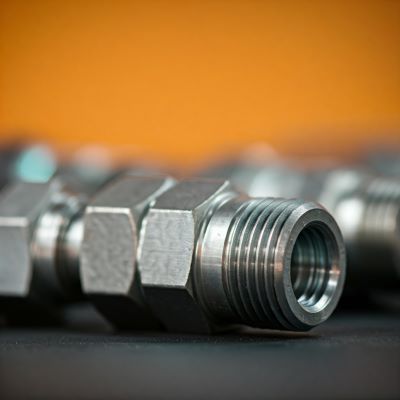Hydraulic systems power a wide range of industries, from construction and manufacturing to aerospace and automotive. These systems operate at incredibly high pressures, making safety a paramount concern.
A single malfunction or failure can lead to catastrophic consequences, including equipment damage, injuries, and environmental hazards. This is where hydraulic high-pressure fittings play a crucial role.
Understanding Hydraulic High Pressure Fittings
Hydraulic high-pressure fittings are specialized components that connect hydraulic hoses and pipes, ensuring a secure and leak-free connection. They are designed to withstand extreme pressure and vibration, preventing fluid leaks and system failures.
Key Components and Materials
➡️ Body: The main structure of the fitting, typically made of steel or stainless steel.
➡️ Nipple or Stud: The threaded part that connects to the hose or pipe.
➡️ Ferrule or Sleeve: A compression fitting that secures the hose or pipe to the nipple.
➡️ O-ring or Seal: A rubber or PTFE ring that prevents leaks.
Common Applications
➡️ Construction equipment
➡️ Agricultural machinery
➡️ Industrial machinery
➡️ Mobile hydraulic equipment
➡️ Aerospace and aviation
The Science Behind Hydraulic High Pressure Fittings
➡️ Pressure Resistance: High-pressure fittings are designed to withstand immense forces exerted by hydraulic fluid.
➡️ Sealing Technology: Advanced sealing techniques, such as O-ring seals and cone-shaped ferrules, ensure a tight seal.
➡️ Stress Distribution: The design of the fitting distributes stress evenly to prevent failure.
Ensuring Leak Prevention and Reliability
➡️ Leak Prevention: Leaks can lead to fluid loss, reduced system performance, and potential safety hazards.
➡️ Advanced Sealing Technologies: Modern fittings employ advanced sealing technologies to minimize the risk of leaks.
➡️ Proper Installation: Incorrect installation can compromise the integrity of the fitting and lead to leaks.
Corrosion Resistance and Material Strength
➡️ Corrosion Resistance: In harsh environments, corrosion-resistant materials like stainless steel are essential.
➡️ Material Strength: The strength and durability of the fitting material directly impact system safety.
Compliance with Industry Standards and Regulations
➡️ Industry Standards: Adherence to industry standards, such as SAE and ISO, is crucial.
➡️ Testing and Certification: Fittings must undergo rigorous testing and certification processes to ensure quality and safety.
Installation Best Practices for Optimal Safety
➡️ Proper Torque: Applying the correct torque is essential to prevent leaks and damage.
➡️ Alignment: Ensure proper alignment of the fitting to avoid stress concentration.
➡️ Avoid Overtightening: Overtightening can damage the fitting and lead to premature failure.
Maintenance and Regular Inspection
➡️ Routine Checks: Regular inspection can identify potential issues early on.
➡️ Signs of Wear and Tear: Look for signs of corrosion, cracks, or damage to the fitting.
➡️ Preventive Maintenance: Implementing a preventive maintenance program can extend the life of the fitting.
Check out these other resources for your gain ⬇️⬇️⬇️
Hydraulic O Ring Kit Maintenance Tips You Should Know
Head Plug Basics [What You Need to Know]
Conclusion
Hydraulic high-pressure fittings are critical components that ensure the safety and reliability of hydraulic systems. By understanding the science behind these fittings, adhering to industry standards, and following best practices, you can minimize the risk of accidents and maximize system performance.
Investing in high-quality fittings and regular maintenance is essential for long-lasting and safe hydraulic systems.
Post time: Dec-03-2024


